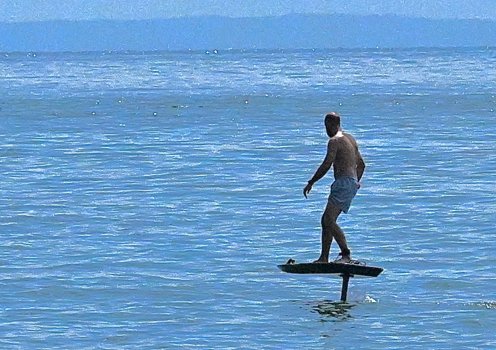Reading time: About 3 minutes
Do you have enough grit? Take a page from the book of my husband’s cousin’s family…
My family and I go up to British Columbia’s Sunshine Coast every summer to visit my husband’s fabulous cousins.
We’re really close to these folks, not just because they’re family, but also because they’re warm, fun, kind and ridiculously hospitable people.
They’ll feed meals to 40 people without batting an eye. Seriously. I once counted 60 for dinner. I’m pretty sure they’d feed a surprise flash mob that just happened to wander by, looking hungry.
Their house sits above the Salish Sea, and if you venture down the long, steep trail to the water, you’ll end up on an idyllic beach, complete with trees for fair-skinned people like me, who burst into flames at the mere mention of UV rays. But there’s also bounteous sunshine for those blessed with more melanin in their skin.
The parents have four adult children in their 30s or early 40s, all of whom have partners and kids of their own.
And most of the adult children are athletic, particularly with watersports. Think Olympic trials, but with more beer and laughter.
One of them, Robert, stands out for his ease on a sporting device called the hydrofoil. It’s kind of a cross between a surfboard and a hovercraft, and it requires a keen sense of balance. You can see him in the photo above.
The good news is that hydrofoils are environmentally friendly. They’re charged electrically and they’re quiet. They don’t make the hellish noise of those dreadful jet-skis, which irritate me every time I have the misfortune to hear one.
The bad news is that hydrofoils are hard to learn to use. Really hard. Think learning to juggle while riding a unicycle. On ice.
But Robert’s brother-in-law, Stew, was up for the challenge. Stew is an athletic Kiwi who was here for a month with his family and anxious to try out the device.
Robert took him down to the beach, gave him some brief verbal instruction and then had the grace to let Stew figure it out for himself. Robert stood by the edge of the water watching benignly while his brother-in-law spent about an hour trying to defy the laws of physics.
We watched as Stew started off on his belly and then carefully pulled himself into a crouch before attempting to stand. The sun beat down, Stew pulled himself up, WHAM, he fell. I lost count of how many times this happened, but it was easily more than a hundred. The man was like a very determined human yo-yo.
As we watched him rise and fall, rise and fall, I thought of grit. It’s a hard word to define, but it’s kind of a magic combination of stamina, passion, patience and persistence. Stew has it. He’s incredibly athletic, but the hydrofoil was a clear example that natural talent is almost never enough. You need to learn. (And, apparently, get very, very wet in the process.)
Grit is also important for writers. Why?
1-It helps you push through resistance
Writing often feels hard, even for seasoned pros. Grit helps writers show up anyway — especially when inspiration is nowhere in sight.
2-It allows you to revise
First drafts are rarely much good. In fact, they’re often terrible — hide-them-from-your-best-friend terrible. Grit fuels the patience and persistence required to revise, reshape and refine your words.
3-It makes you better at handling rejection
From agents to editors to readers, writers face a lot of “no.” So many nos that you could sometimes wallpaper a room with rejection letters. Grit allows writers to absorb the blow, learn from it and keep going.
4-It enables you to stick with a project for the long haul
Real progress comes from consistent effort over months and years. Grit helps you maintain discipline even when results are slow to appear and your inner critic is having a field day.
5-It helps you deal with self-doubt
Writers regularly battle imposter syndrome and creative insecurity. Surely you’re familiar with that charming voice whispering, “Who are you kidding? You can’t write!” Grit gives you the courage to write through fear and uncertainty.
Hydrofoil lessons for life
I am not the kind of person who would ever attempt a hydrofoil. I don’t have the athleticism for it. In fact, I felt grateful I could climb the hill up from the beach without requiring oxygen and a Sherpa.
But I am always able and happy to push myself, hard, with writing and editing.
And I was delighted to see Robert and Stew display pure grit in the warm summer sun. It was like watching poetry in motion — if poetry involved a lot more splashing and significantly fewer metaphors.
If you liked this post, you’ll also like Do your writing habits reveal grit?
*
Would you like to develop some more grit for your writing or editing? Learn about my three-month accountability program called Get It Done. There is turn-over each month, and priority will go to those who have applied first. You can go directly to the application form and you’ll hear back from me within 24 hours.
*
My video podcast last week was on how to write better in English if you speak it as a second language. You can watch the video or read the transcript, and you can also subscribe to my YouTube channel.
*
How do you display grit with your writing? We can all learn from each other, so please, share your thoughts with my readers and me in the comments section, below. If you comment on today’s post (or any others) by Aug. 31/25, I’ll put you in a draw for a digital copy of my first book, 8 1/2 Steps to Writing Faster, Better. To enter, please scroll down to the comments, directly underneath the related posts links, below. You don’t have to join Disqus to post! Read my tutorial to learn how to post as a guest. (It’s easy!)


